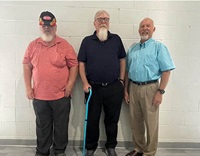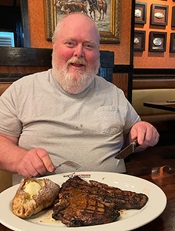Parkinson’s disease was seriously interfering with Eric Simmons’ daily routine. When he tried to cook on the stove, his feet would lock up, even while he was holding a hot pan. His walking issues made it difficult for him to sweep the floor. He couldn’t grip a fork and knife to cut up his food. His hand tremors became so severe that his hands would rub against his pants, wearing holes in the fabric.
“My walking was getting worse,” notes Eric. “I would take little stutter steps, meaning I would stop and almost trip forward. It was like my body was going faster than my feet could handle. Although I never fell, I would have to stop and straighten up before I could start walking again.”
Eric became one of the first patients at Atrium Health to receive asleep deep brain stimulation (DBS), an innovative surgical technique that sends electrical signals to the brain to control movement. His significant symptom improvement confirms the benefits of asleep DBS for Parkinson’s patients, encouraging others to consider the treatment earlier in their disease journey.
Worsening symptoms lead to a surgical solution
Eric first started experiencing hand tremors at age 50. Dr. Richard Harsch, family medicine physician with Atrium Health Primary Care Cabarrus Family Medicine, suspected Eric might have Parkinson's disease. Harsch referred Eric to Dr. Bing Liu, neurologist with Atrium Health Neurology, to confirm the diagnosis. Liu tried several medications before finding one that best managed Eric’s Parkinson’s symptoms.

After several years, Eric’s Parkinson’s worsened and began to affect his walking. At age 59, Liu suggested he try asleep DBS. While DBS therapy has been around for 30 years, the last three to five years have brought significant advancements, particularly in how stimulation is delivered and the system is implanted.
“I was on the fence,” says Eric. “I didn’t like the idea of putting wires and electricity in my brain.”
Harsch’s brother, who lives in New York, also has Parkinson’s and uses a DBS system to control his symptoms. With permission, Harsch put Eric in touch with his brother to discuss the details of the procedure.
“After our conversation, I knew for sure that I wanted to move forward with DBS,” Eric recalls.
Improved image placement, reduced anxiety
 In the past, one of the major hesitations surrounding DBS was the need for patients to be awake during brain surgery.
In the past, one of the major hesitations surrounding DBS was the need for patients to be awake during brain surgery.
“With the development of asleep DBS, we’ve been able to place electrodes with just as much, if not better, accuracy,” says Dr. Martin Henegar, neurosurgeon with Carolina NeuroSurgery & Spine Associates (CNSA). “This has overcome a significant barrier, allowing patients to benefit from this transformative intervention, which can significantly enhance their well-being and quality of life. They can have the surgery with minimal discomfort and anxiety.”
Advances in imaging and technology now allow neurosurgical experts to place electrodes more precisely and consistently, ensuring better patient outcomes.
“We use intraoperative imaging, which allows us to see the electrode placement in real time, relative to the target site, during the procedure,” Henegar explains. “This technology allows us to make adjustments as needed, ensuring optimal results.”
Collaborative, compassionate care
Liu referred Eric to Dr. Danielle Englert, movement disorder neurologist and director of the Movement Disorder and DBS Program at Atrium Health Neurosciences Institute, to complete a series of tests, including cognitive assessments, and exams to qualify for the procedure. Eric passed them all with flying colors.
Englert referred Eric to Henegar to schedule his procedure. Englert worked with Henegar on Eric’s surgical planning and was present in the operating room to confirm the placement of the leads using intraoperative imaging.
Eric’s DBS procedure required two operations. For the first surgery, Henegar put the implantable pulse generator in Eric’s chest. This pacemaker-like device sends electrical signals to the brain. Nine days later, Henegar created two burr holes in Eric’s skull to insert electrodes, which were connected to an extension wire leading to the implantable pulse generator.
Thanks to the collaborative efforts of the CNSA surgical team and the neurology team at Atrium Health, Eric had minimal discomfort and excellent results.
“Everyone on my care team was extremely kind,” Eric says. “Their warmth made me feel comfortable and really put me at ease.”
Eric especially appreciated Englert’s calm and polite demeanor, which helped him feel more relaxed throughout the process. Englert’s primary nurse consistently showed Eric kindness and took a personal interest in his well-being. Henegar played a key role in preparing Eric for surgery, patiently answering his questions and making sure he understood every step.
Continuous symptom control, 50% medication reduction
 Neurologists have found DBS to be highly effective in reducing tremors, improving mobility and easing symptoms such as rigidity and bradykinesia (slowness of movement).
Neurologists have found DBS to be highly effective in reducing tremors, improving mobility and easing symptoms such as rigidity and bradykinesia (slowness of movement).
“DBS stimulation is on continuously, providing symptom control both day and night without any breakthroughs,” notes Englert. “This is a significant advantage over medication, which tends to wear off after a few hours, causing symptom fluctuations. DBS significantly reduces motor fluctuations and helps control refractory tremors – those that don’t respond to standard medications.”
On average, DBS has helped Parkinson’s patients at Atrium Health reduce their medications by 50%, and more than half of patients have been able to cut back by 50%-90%. Parkinson’s medications often cause side effects such as nausea, blood pressure fluctuations, hallucinations and involuntary movements.
“When we can’t increase medication doses any further, surgery becomes a highly effective next option,” Englert says.
Englert’s team encourages patients to consider DBS earlier in their Parkinson's journey – when it can provide the greatest benefit. By removing barriers to this treatment, even those who may not be immediate candidates can stay informed and be better prepared to take advantage of it in the future.
Immediate symptom relief
Three weeks after Eric’s DBS system was implanted, Englert activated it for the first time. It was an exciting moment for both Englert and Eric.
“My hand had been shaking, but as Dr. Englert gradually increased the stimulation, the tremor stopped,” Eric explains. “It was the first time my hand had been still in nine years.”
Eric also saw an immediate improvement in his walking. Englert made adjustments to the DBS system’s settings and had Eric walk down the hallway. While it wasn’t perfect, there was a noticeable difference. Eric described it as being able to take more normal steps – longer, smoother strides instead of a series of short, shuffling steps. He wasn’t dragging his feet as much, and his gait felt more natural.
Eric completed physical therapy on his feet and legs, which helped him regain mobility and return to an active lifestyle.
“I still keep up with some exercises at home,” says Eric. “I bought a set of bicycle pedals, which I use at night to keep my legs moving. The more I move them, the easier it is to walk.”
Since starting DBS treatment, Eric’s hand tremors have stopped completely. He’s experienced about a 50% improvement in his legs and feet and remains optimistic that his walking will continue to improve. Although Eric was initially able to reduce his Parkinson’s medications after undergoing DBS, he has since had to increase his dosage to manage his symptoms.
A taste of freedom

To celebrate his remarkable health success, Eric went to a restaurant with his oldest brother and sister-in-law.
“I sat down and ordered a big ole steak,” Eric says with a smile. “It was the first time I could cut my own steak in nine years. That steak tasted really good.”
Learn more about Parkinson’s disease care at Atrium Health Neurosciences Institute.



